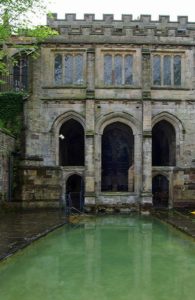This must be unique in Britain, a Holy Well that has been the continuous site of pilgrimage for over 1300 years. Set off the usual tourist beat in North East Wales, it is definitely worth finding.
It survived the Reformation and the Puritan zeal to destroy ‘popish’ shrines. It is still visited by pilgrims today, not just from Wales but across Europe. After the miracle at Lourdes, pilgrimage to Holywell took off and a branch line was built to bring pilgrims to the well, although numbers dropped off after the First World War.
Around 660AD, Saint Winifred spurned the advances of Caradoc, son of a local prince as she wanted to become a nun. He cut off her head in his anger. A spring rose from the ground at the spot where her head fell. Winefride was restored to life by her uncle, St. Bueno. He called down the wrath of God on Caradoc who was struck dead and swallowed up. Bueno sat on a stone and vowed if anyone sit or stand on that spot and ask God’s help three times in Winefride’s name, that help would be granted. St Winefride became a nun and later and abbess. She was buried in Shrewsbury Abbey.
News of the healing powers of the spring spread and pilgrims came to be cured. A town developed round the spring from Norman times, providing accommodation for pilgrims. Pilgrims spent the night in vigil before they bathed three times in the well, saying a decade of rosary. Afterwards they left votive offerings.
Everyone who was anyone visited the shrine. Richard I visited the site in 1189 to pray for the success of his crusade, and Henry V was said by Adam of Usk to have travelled there on foot from Shrewsbury in 1416. James II is known to have visited the well with his wife Mary of Modena during 1686, after several failed attempts to produce an heir to the throne. Shortly after this visit, Mary became pregnant with a son, James.
As numbers of pilgrims grew, a second pool was built. The building around the well with a chapel above was built at the beginning of the 16thC and is a marvellous example of Perpendicular architecture.
This is unique in Europe and was one of the most impressive structures of its time. The spring arises in a star shaped basin and is still bubbling today. This was originally surrounded by a stone screen, although the arches were destroyed by the Puritans. Round the outside is an ambulatory. Above is a vaulted ceiling with decoratively carved bosses. No one is quite sure who was responsible for building the shrine. It may have been Abbot Thomas Pennant of nearby Bassingwerk Abbey. He had many wealthy patrons including Margaret Beaumont, mother of Henry VII. Her coat of arms is on one of the bosses as well of those of other patrons.
The water flows from the star shaped pool into the later rectangular pool with steps down into it. This is open for bathing everyday. Each day at mid day a short service is still held by the well. The official pilgrimage season is from Whitsunday to 30th September, although pilgrims visit throughout the year. The Annual pilgrimage is held on June 22nd (or the Sunday after if it is a weekday), as this is the anniversary of Winefride’s death and miraculous return to life. There are other major pilgrimages at other times by the Orthodox Church, Knights of Malta and other organisations.
There is a small Visitor Centre with shop and exhibition about St Winefride, the well and pilgrimages. The separated tall building to the right of the shrine is the Victorian curator’s house. This now houses a museum of relics which is only open Wednesday afternoons.
Next to the 16thC shrine is a small building with steps leading into it. It contains a replica of Gambarelli Rosselino’s Virgin with laughing child. The original was a masterpiece of the Italian renaissance. There is a crucifix on the wall and a lovely modern stained glass window with St Winefride and St Beuno. Pilgrims (and visitors) can light a candle here.
When visiting the well, look out for the graffiti carved on the walls of the screen, giving thanks for cures. On a wall is a statue of St Winefride under an ogee arch holding an Abbess’s crook and a feather.
The chapel above is in the care of CADW and is kept locked. A key can be obtained from the visitor centre (£5 refundable deposit). The door is on the south side, on the opposite side to the well and reached by steps. It is a small rectangular building with nave, small north aisle separated by an arcade of low pointed arches. At the end is a small five sided chancel. The inside is empty. It has a wood beamed roof with carved bosses supported on corbels with carved heads and animals and a narrow carved fringe around the base.
The large Church of St James above the shrine is the parish church, but was locked. There was no information about a key holder.
Entry only costs a few pennies. The visitor Centre and well are accessible to wheelchair users and there is a wheelchair available. There is free parking across the road.
Next to it, the Mill on the Hill Tea Room offers cheap and good food.
This is a fascinating site, and still has the power to move.








